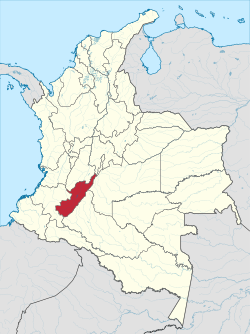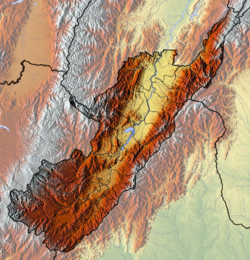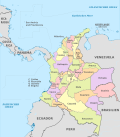| Department of Huila Departamento del Huila | |
|---|---|
| Department | |
 The Tatacoa Desert The Tatacoa Desert | |
 Flag Flag Coat of arms Coat of arms | |
| Anthem: Alma del Huila (Huila's soul) | |
 Huila shown in red Huila shown in red | |
 Topography of the department Topography of the department | |
| Coordinates: 2°59′55″N 75°18′16″W / 2.99861°N 75.30444°W / 2.99861; -75.30444 | |
| Country | |
| Region | Andean Region |
| Department established | 1905 |
| Province established | 1610 |
| Capital | Neiva |
| Government | |
| • Governor | Luis Enrique Dussán López |
| Area | |
| • Total | 19,890 km (7,680 sq mi) |
| • Rank | 26th |
| Population | |
| • Total | 1,200,386 |
| • Rank | 15th |
| • Density | 60/km (160/sq mi) |
| GDP | |
| • Total | COP 24,012 billion (US$ 5.6 billion) |
| Time zone | UTC-05 |
| ISO 3166 code | CO-HUI |
| Provinces | 4 |
| Municipalities | 37 |
| HDI (2019) | 0.726 high · 22nd of 33 |
| Website | https://www.huila.gov.co/ |
Huila (Spanish pronunciation: [ˈwila]) is one of the departments of Colombia. It is located in the southwest of the country, and its capital is Neiva.
Demography and Ethnography
Huila department had a population of 1,122,622 inhabitants in 2020, of which 679,667 (60.54%) live in urban areas and 442,955 (39.46%) in the rest of the Huilense territory. This amounts to 2.5% of the total Colombian population. The majority of it is settled in the Magdalena valley, the main urban centers being Neiva and Garzón, due to the possibilities offered by commercial-type agricultural economy, oil production, access to basic public services and roads connected to the central road axis along the Magdalena. The rest of the population is located on the coffee belt, standing out Pitalito and La Plata; the North Subregion is undergoing a decrease in its rural population, mainly attributable to alterations of agricultural and oil activities on the landscape. The average population density in the department is 59.88 inhabitants / km, with the highest densities in Neiva (223.72), Pitalito (200.1) and Garzón (162.45), and with the lowest in the municipalities of Colombia and Villavieja (7.83 and 10.91 respectively).
Ethnography
According to DANE, the racial composition of Huila is as follows: 98.43% recognize themselves as Whites and Mestizos, while only 1.57% as an ethnic population (Amerindians and Afro/Mulattos). This makes it one of departments with the highest percentage of non-ethnic affiliated population in the country.
Geography
| Year | Pop. | ±% |
|---|---|---|
| 1973 | 467,651 | — |
| 1985 | 693,712 | +48.3% |
| 1993 | 843,798 | +21.6% |
| 2005 | 1,011,418 | +19.9% |
| 2018 | 1,100,386 | +8.8% |
| Source: | ||
According to the Agustín Codazzi Geographic Institute (IGAC), Huila's surface area is 19,890 km², which is about 1.74% of the total surface area of Colombia.
The south of the department is located in the Colombian Massif. The Cordillera Oriental branches off from the Colombia Massif here. This is caused by the rise of the Magdalena River (also called Yuma River), Colombia's longest river and its largest basin. The Magdalena River has two large dams: Betania and El Quimbo.
Colombia's third highest peak, Nevado del Huila volcano, is also located in this department.

Administrative divisions
Municipalities
- Acevedo
- Agrado
- Aipe
- Algeciras
- Altamira
- Baraya
- Campoalegre
- Colombia
- Elías
- Garzón
- Gigante
- Guadalupe
- Hobo
- Iquira
- Isnos
- La Argentina
- La Plata
- Nátaga
- Neiva (capital city)
- Oporapa
- Paicol
- Palermo
- Palestina
- Pital
- Pitalito
- Rivera
- Saladoblanco
- San Agustín
- Santa María
- Suaza
- Tarqui
- Tello
- Teruel
- Tesalia
- Timaná
- Villavieja
- Yaguará
References
- "DANE". Archived from the original on November 13, 2009. Retrieved February 13, 2013.
- "Producto Interno Bruto por departamento", www.dane.gov.co
- "Sub-national HDI - Area Database - Global Data Lab". hdi.globaldatalab.org. Retrieved 2018-09-13.
- "Generalidades del departamento". Gobernación del Huila. Retrieved 26 April 2013.
- "Ficha de Caracterización - DPN 2020 Huila" (PDF).
- "Población 2018". sirhuila.gov.co. Retrieved 2021-09-03.
- "Censo Nacional de Población y Vivienda 2018".
- "Reloj de Población". DANE. Departamento Administrativo Nacional de Estadísitica. Archived from the original on 16 January 2018. Retrieved 6 July 2017.
External links
- (in Spanish) Government of Huila official website
| Departments of Colombia | ||||||||
|---|---|---|---|---|---|---|---|---|
 | ||||||||